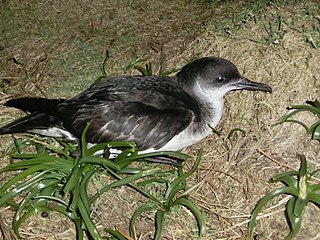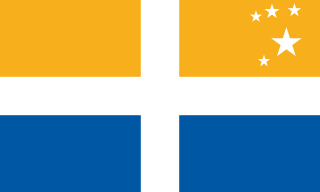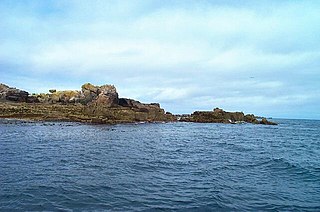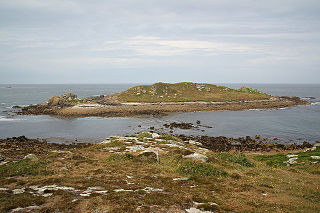| Formation | 1985 |
|---|---|
| Type | Registered Charity |
| Headquarters | Trenoweth |
| Location | |
Chief Executive | Julian Branscombe |
| Website | Isles of Scilly Wildlife Trust |
The Isles of Scilly Wildlife Trust, formed in 1985, is a Wildlife Trust covering the Isles of Scilly, a group of islands off the coast of Cornwall. [1] It became the 46th member of The Wildlife Trusts in 2001 and is dedicated to ensuring that the archaeological and historical remains on the islands, as well as the flora and fauna, are protected and maintained. [2] Since September 2021, the Chief Executive of the trust has been Julian Branscombe. [3]
The Isles of Scilly Wildlife Trust, a small, local independent charity, leases all of the uninhabited islands, islets and rocks and much of the remaining "untenanted land" (including almost all the coast) on the inhabited islands from the Duchy of Cornwall for a peppercorn rent of one daffodil per year. [4] As tenants of the Duchy of Cornwall the Isles of Scilly Wildlife Trust has a 99 year fully insuring, repairing lease and is responsible for more than 50% of the Islands. The Trust previously worked in conjunction with the Cornwall Wildlife Trust and jointly produced a thrice yearly magazine called Wild Cornwall & Wild Scilly which ended in the Summer 2014 edition. Members are now sent an e-newsletter. [5]
In 2013, the Isles of Scilly Seabird Recovery Project was set up by the Duchy of Cornwall, the Royal Society for the Protection of Birds (RSPB), Natural England, the Isles of Scilly Area of Outstanding Natural Beauty and the Isles of Scilly Wildlife Trust. The five-year project aims to keep the islands of St Agnes and Gugh, brown rat (Rattus norvegicus) free, to help breed sea birds, which lost 25% of their populations between 1983 and 2006. The rats eat eggs and kill the chicks of those birds that nest in burrows or on the ground. Rat removal began in October 2013, by a team of thirty volunteers led by Wildlife Management International Limited (WMIL) of New Zealand, and there have been no signs of rats on St Agnes and Gugh since December 2013. WMIL returned to the islands to do a final check for rats in 2016. [6]
In 2014, Manx shearwater (Puffinus puffinus) bred on both Gugh and St Agnes for the first time in living memory, and a survey of St Agnes in July 2015 found European storm petrel (Hydrobates pelagicus) at six nests. A follow-up in early September, to confirm breeding, found storm petrel chicks at each of the sites. Storm petrel also bred on Gugh in 2015. [7]

The family Procellariidae is a group of seabirds that comprises the fulmarine petrels, the gadfly petrels, the diving petrels, the prions, and the shearwaters. This family is part of the bird order Procellariiformes, which also includes the albatrosses and the storm petrels.

The European storm petrel, British storm petrel, or just storm petrel is a seabird in the northern storm petrel family, Hydrobatidae. The small, square-tailed bird is entirely black except for a broad, white rump and a white band on the under wings, and it has a fluttering, bat-like flight. The large majority of the population breeds on islands off the coasts of Europe, with the greatest numbers in the Faroe Islands, United Kingdom, Ireland, and Iceland. The Mediterranean population is a separate subspecies, but is inseparable at sea from its Atlantic relatives; its strongholds are Filfla Island (Malta), Sicily, and the Balearic Islands.

The Manx shearwater is a medium-sized shearwater in the seabird family Procellariidae. The scientific name of this species records a name shift: Manx shearwaters were called Manks puffins in the 17th century. Puffin is an Anglo-Norman word for the cured carcasses of nestling shearwaters. The Atlantic puffin acquired the name much later, possibly because of its similar nesting habits.

St Agnes is the southernmost populated island of the Isles of Scilly. Thus the island's Troy Town Farm is the southernmost settlement in the United Kingdom.

Bryher is one of the smaller of the inhabited islands of the Isles of Scilly, with a population of 84 in 2011, spread across 134 hectares (1.34 km2).

Annet is the second largest of the fifty or so uninhabited Isles of Scilly, 1 kilometre (0.62 mi) west of St Agnes with a length of 1 kilometre (0.62 mi) and approximately 22 hectares in area. The low-lying island is almost divided in two by a narrow neck of land at West Porth which can, at times, be covered by waves. At the northern end of the island are the two granite carns of Annet Head and Carn Irish and three smaller carns known as the Haycocks. The rocky outcrops on the southern side of the island, such as South Carn, are smaller. Annet is a bird sanctuary and the main seabird breeding site in Scilly.

Round Island Lighthouse, in the Isles of Scilly was designed by William Tregarthen Douglass for Trinity House and completed in 1887. At the time of building it was one of three lights in the Isles of Scilly, the others being the Bishop Rock and St Agnes lighthouse. The light was modernised in 1966, automated in 1987 and the island designated as a Site of Special Scientific Interest (SSSI) in 1995. It is now managed by the Isles of Scilly Wildlife Trust, and except for the maintenance of the Grade II listed lighthouse, landing is not allowed.

Gugh could be described as the sixth inhabited island of the Isles of Scilly, but is usually included with St Agnes with which it is joined by a sandy tombolo known as "The Bar" when exposed at low tide. The island is only about 1 km (0.62 mi) long and about 0.5 km (0.31 mi) wide, with the highest point, Kittern Hill at 34 m (112 ft). The geology consists of Hercynian granite with shallow podzolic soils on the higher ground and deeper sandy soils on the lower ground. The former Gugh farm is just north of the neck across the middle of the island between the two hills. The two houses were designed and built in the 1920s by Charles Hamlet Cooper. The name is often mispronounced as "Goo", "Guff" or even "Gogh".

Teän is an uninhabited island to the north of the Isles of Scilly archipelago between Tresco, 1.5 kilometres (0.9 mi) to the west, and St Martin's, 300 metres (330 yd) to the east. Approximately 16 hectares in area, the island consists of a series of granite tors with the highest point, Great Hill, rising to 40 metres (130 ft) at its eastern end. The low-lying land is overlain with glacial till and outwash gravels with glacial erratics abundant on the north coast beaches, which indicates the southern limit of outwash from an ice sheet for which it is designated a Geological Conservation Review site.

Austral storm petrels, or southern storm petrels, are seabirds in the family Oceanitidae, part of the order Procellariiformes. These smallest of seabirds feed on planktonic crustaceans and small fish picked from the surface, typically while hovering. Their flight is fluttering and sometimes bat-like.

The Isles of Scilly is an archipelago off the southwestern tip of Cornwall, England. One of the islands, St Agnes, is the most southerly point in Britain, being over four miles further south than the most southerly point of the British mainland at Lizard Point.

Rosevear is the largest of the group of rocks known as the Western Rocks, Isles of Scilly. The islands are on eastern side of the Atlantic Ocean on the south-west approaches to the island of Great Britain and are renowned for the numerous shipwrecks in the area and the nearby Bishop Rock lighthouse. All the uninhabited islands are owned by the Duchy of Cornwall and are managed by the Isles of Scilly Wildlife Trust, which looks after the archaeological and historical remains on the islands, as well as the flora and fauna. Landing is not allowed on the island.

The birds of Cornwall are in general a selection of those found in the whole of the British Isles, though Cornwall's position at the extreme south-west of Great Britain results in many occasional migrants. The nightingale is one common English bird which is virtually absent from Cornwall.

White Island is one of the larger unpopulated islands of the Isles of Scilly, part of the United Kingdom, and lies off the coast of the northernmost populated island of the group, St Martin's, to which it is joined by a tidal causeway, or isthmus. The island is designated as a Site of Special Scientific Interest (SSSI) and a Geological Conservation Review site and is managed by the Isles of Scilly Wildlife Trust on behalf of the Duchy of Cornwall.

The Western Rocks are a group of uninhabited skerries and rocks in the south–western part of the Isles of Scilly, United Kingdom, and are renowned for the numerous shipwrecks in the area and the nearby Bishop Rock lighthouse. In 1971, the rocks and islands were designated a Site of Special Scientific Interest for their breeding sea birds. Landing on the islands is both difficult and discouraged and there are few published records of visits by naturalists.

Seabirds include some of the most threatened taxa anywhere in the world. For example, of extant albatross species, 82% are listed as threatened, endangered, or critically endangered by the International Union for Conservation of Nature. The two leading threats to seabirds are accidental bycatch by commercial fishing operations and introduced mammals on their breeding islands. Mammals are typically brought to remote islands by humans either accidentally as stowaways on ships, or deliberately for hunting, ranching, or biological control of previously introduced species. Introduced mammals have a multitude of negative effects on seabirds including direct and indirect effects. Direct effects include predation and disruption of breeding activities, and indirect effects include habitat transformation due to overgrazing and major shifts in nutrient cycling due to a halting of nutrient subsidies from seabird excrement. There are other invasive species on islands that wreak havoc on native bird populations, but mammals are by far the most commonly introduced species to islands and the most detrimental to breeding seabirds. Despite efforts to remove introduced mammals from these remote islands, invasive mammals are still present on roughly 80% of islands worldwide.

Wingletang Down is a Site of Special Scientific Interest (SSSI) on the southern side of the island of St Agnes in the Isles of Scilly, England, UK, which is noted for its biological characteristics. The site is managed by the Isles of Scilly Wildlife Trust and is within the Isles of Scilly Heritage Coast and the Isles of Scilly Area of Outstanding Natural Beauty. It is the only site in Great Britain and Ireland for the small fern, least adder's–tongue. As of 11 September 2009 the SSSI was considered to be in ″unconditional recovering″ condition because European gorse and bramble are at unacceptable levels.

The Eastern Isles are a group of twelve small uninhabited islands within the Isles of Scilly Area of Outstanding Natural Beauty, part of the Scilly Heritage Coast and a Site of Special Scientific Interest (SSSI) first designated in 1971 for its flora and fauna. They have a long period of occupation from the Bronze Age with cairns and entrance graves through to Iron Age field systems and a Roman shrine on Nornour. Before the 19th century, the islands were known by their Cornish name, which had also become the name of the largest island in the group after the submergence of the connecting lands.

The Norrard (Northern) Rocks are a group of small uninhabited granite rocks in the north–western part of the Isles of Scilly, to the west of Bryher and Samson. In 1971 they were designated as a Site of Special Scientific Interest (SSSI) for their breeding seabird colonies and they are permanently closed to landings from boat passengers. The vegetation on the islands is limited by the extreme exposure and only six species of flowering plants have been recorded.
The Isles of Scilly are an archipelago 45 km (28 mi) off Land's End, Cornwall. Little of the fauna on, above or in the seas surrounding the isles was described prior to the 19th century, when birds and fish started to be described. Most records of other animals date from the 20th century onwards.